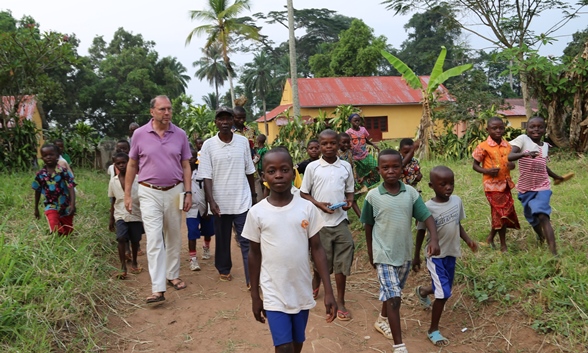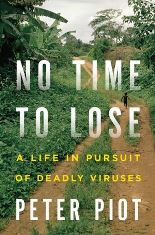The Disease Detective

As Ebola wreaks havoc once again in Africa, microbiologist Professor Peter Piot recalls how he and his team helped stop the spread of the disease when it first appeared in the 70s
The Biologist 62(1) p16-20
In 1976, Belgian microbiologist Professor Peter Piot received a thermos flask containing ice, vials of blood and a note from a Belgian doctor based in Zaire (now the Democratic Republic of Congo). The blood was from a Belgian nun, one of many people in a remote rural region of Zaire who had become seriously ill with a mysterious illness. The flask had been sent as hand luggage on a commercial flight and, because one of the vials had smashed en route, blood and melted ice sloshed around inside.
After examining the blood under a microscope, Piot saw it contained a distinct and unusual virus – large and worm like. After consulting experts from around the world, he realised that the haemorrhagic pathogen was entirely new to science. Within weeks, together with a team of international scientists, Piot travelled to the epicentre of the outbreak in the village of Yambuku. They named the virus after a nearby river: the Ebola.
Fast forward to 2015 and an Ebola outbreak is again causing death and suffering in West Africa, and on a much larger scale. Here, Professor Piot describes his latest thoughts on the epidemic and, in an extract from his book, describes how he and his colleagues began to build a picture of how the devastating disease was spreading.
As the Ebola outbreak in West Africa continues to claim thousands of lives, a difficult path lies ahead of us. Transmission in dense urban areas has contributed to a 'perfect storm' scenario that has characterised the catastrophic nature of this outbreak with each individual factor being worse than usual. It has presented us with challenges never before seen, and the high proportion of transmission occurring in the community has been a defining issue of this crisis.
Cases continue to surge in Sierra Leone, but news of a potential decline in Liberia is encouraging. While the reasons behind the decline of cases in Liberia are unclear, it is likely that changes in the behaviour of local communities have played a significant role in reducing transmission. Improving public knowledge about caring for the sick and changing burial practices to prevent transmission through bodily fluids is a complex challenge, but it is one we must tackle to bring this epidemic to an end.
 As a young microbiologist working with colleagues on the first Ebola outbreak in 1976, we had no clue at first how the virus was transmitted. The following account describes the time in the Democratic Republic of Congo when we began to understand how the virus was spreading.
As a young microbiologist working with colleagues on the first Ebola outbreak in 1976, we had no clue at first how the virus was transmitted. The following account describes the time in the Democratic Republic of Congo when we began to understand how the virus was spreading.
"Night by night, as we jotted down data and sketched out a picture from our interviews and notes, it appeared that although people were still dying (and dying horribly), the peak number of new infections around the Yambuku mission might be, at least provisionally, behind us.
This was a huge relief. But another conclusion also began to take shape, and it was a great deal more uncomfortable to deal with. Two elements linked almost every victim of the mystery epidemic. One factor was funerals: many of the dead had been present at the funeral of a sick person or had close contact with someone who had. The other factor was a presence at the Yambuku Mission Hospital. Just about every early victim of the virus had attended the outpatient clinic a few days before falling ill.
We developed near-certitude about the mode of transmission one evening, when Joel [Breman] and I were drawing curves showing the number of cases by location, age and gender. (Working with Joel was a real education, like a terrific crash course in epidemiology.) It seemed likely by this point that aerosol contact was not enough to transmit the disease. But particularly in the 18 to 25 age group, at least twice as many women had died as men. We knew that there was something fishy about the hospital, and about funerals, but this was the real clue. What's different in men and women at that age?
Being a bunch of men, it took us a little time to figure out the answer. Women get pregnant. And indeed, almost all of the women who had died had been pregnant, particularly in that age group, and they had attended the antenatal clinic at the Yambuku mission.
Masamba [Matondo] and [Jean-Francois] Ruppol were the first to figure out the picture. Vitamin shots. They were usually completely pointless, but many African villagers considered them vital: to them the act of injection with a syringe was emblematic of Western medicine. Thus there were two words for Western medicine in the region. Anything ingested orally was 'aspirin', and it was hopelessly weak. An injection was 'dawa', proper medicine – something strong and effective.
We needed to take another tour of the Yambuku hospital. Knowing what we now did, the empty rooms and bare metal bed frames of the mission hospital seemed more disturbing – grim killers of the joyful young mothers who had come there to be cared for but left with a lethal disease. When we reached the stock room, we hunted through the large multi-dose jars of antibiotics and other medications. Their rubber bungs had been perforated multiple times by syringes. In some cases the bung had been removed and was stuck down with a simple bandage. Nearby were a few large glass syringes, five or six.
We politely interviewed the nuns. Sister Genoveva told us quite freely that the few glass syringes were reused for every patient every morning, she told us, they were quickly (and far too summarily) boiled, like the obstetric instruments employed in the maternity room. Then all day long they were employed and re-employed; they were simply rinsed out with sterile water.
She confirmed that the nuns dosed all the pregnant women in their care with injections of vitamin B and calcium gluconate. Calcium gluconate is a salt of calcium and gluconic acid; it has basically no medical value in pregnancy, but it delivers a shot of energy, and this temporary 'high' made it very popular among patients.
In other words, the nurses were systematically injecting a useless product to every woman in antenatal care, as well as to many of the other patients who came to them for help. To do so, they used unsterilised syringes that freely passed on infection. Thus, almost certainly, they had unwittingly killed large numbers of people. It looked as though the only obstacle to the epidemic had been the natural intelligence of the villagers, who saw that many of the sick came from the hospital, and thus fled it; who knew to set up at least some barriers to travel, thus creating a semblance of quarantine.
The nuns were totally committed women. They were brave. They faced an incredibly difficult environment and they dealt with it as best they could. They meant well. We had shared their table and their lives for what seemed like far longer than four days, and every evening, as they sipped their little tots of vermouth, they had told us about the villages of their childhoods. Every evening the discussion had ended up circling around and around the same subject – the epidemic: who had fallen ill first, when and how it had happened; the dread of infection; the horrible deaths of patients and colleagues.
They had been trying to map out the frightening terrain until, I suppose, it would seem more manageable, less horrific. It was a narrative in which they had felt like heroes of a sort, and certainly martyrs.
Now it appeared that they were in some sense villains as well. It was very hard to formulate the words that would inform the sisters that the virus had in all likelihood been amplified and spread by their own practices and lack of proper training. In the end I think we were far too polite about it: I'm not certain at all that it really sank in when we told them our preliminary conclusions.
Adapted from the book No Time to Lose: A Life in Pursuit of Deadly Viruses by Peter Piot, with permission of the author and publisher, W W Norton & Co
Ebola: The key facts
Ebola virus disease (EVD), formerly known as Ebola haemorrhagic fever, is a severe, often fatal illness in humans.
Fruit bats of the Pteropodidae family are believed to be Ebola virus hosts. The virus is transmitted to people from wild animals and spreads in the human population through human-to-human transmission.
The virus is one of a small group of viruses known as filoviruses (Filoviridae), which form long string-like infectious particles.
The current outbreak in West Africa has killed more than all other Ebola outbreaks combined.
There is as yet no proven treatment available. A range of potential treatments including blood products, immune therapies and drugs are being evaluated.
At the time of going to press there had been nearly 22,000 cases and 8,600 deaths in West Africa since March 2014.
The World Health Organization has declared the outbreak in Nigeria, Mali and Senegal over, and the number of new cases is now falling in Guinea, Liberia, and Sierra Leone.
Professor Peter Piot is director of the London School of Hygiene & Tropical Medicine, and former executive director of UNAIDS and Under-Secretary General of the UN. He co-discovered Ebola in 1976.


